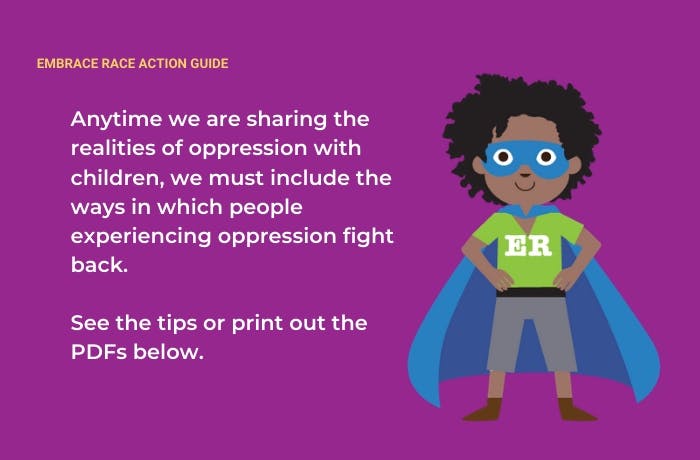7 Ways to Highlight Resistance Efforts When Discussing Oppression with Children
By Mia Birdsong

All children need to learn about oppression so they can identify it and contextualize it. But racism and white supremacy (and sexism, homophobia, etc.) can be painful and scary concepts for kids—especially when they match up with their lived experiences. They have to know that there are people actively working to fight against these systems. Anytime we are sharing the realities of oppression, we must include the ways in which people experiencing oppression fight back.
Children need ways to understand their own agency as well, though kids of color and white kids should understand their roles differently. In talking about resistance, we give children examples of what it looks like to be agents of change. We show them that people who experience oppression are not powerless or mere victims. They can do something.
1) Start with books.
I love using children’s books as a vehicle for introducing topics to kids. There are some great books that teach kids (and adults) about real Freedom Fighters. Henry’s Freedom Box, Toussaint L’ouverture: The Fight for Haiti’s Freedom, The Streets Are Free, Little Rock Nine.
2) Be present.
Fighting for liberation is still happening! There are a lot of folks who are doing the important work of fighting oppression today. Black Youth Project 100, 18 Million Rising, Presente.
3) Pay attention to gender.
Kids are much more likely to hear about cismen—King, Chavez, Peltier, Itliong—and not as much about the women and trans folks who have always been as critical in making change happen.
4) Include artists and musicians.
Every political movement has its art forms. And art and music are easy ways for children to connect to movements for freedom. You can even make political art together! Fela Kuti, Melanie Cervantes, Gordon Parks, LaToya Ruby Frazier.
5) Include youth.
Some of our most important Freedom Fighters were young people. Resistance is not just for grown ups, and plenty of children and young adults have been part of some of our most important struggles. Ruby Bridges, Malala Yousafzai, The Children’s Crusade.
6) Encourage activism.
From writing a letter to a representative to joining a march to organizing an action, there are so many ways for kids to make a real difference—beyond feel-good actions like coat drives and park clean-up.
7) Mindfully include white people.
We have to eliminate the White Savior role, which
centers whiteness and portrays people of color as
victims. But white kids should know that they can
play an important support role when it comes to
fighting racism. Emphasize and prioritize the
efforts of people of color, but include white allies
too. John Brown, Viola Liuzzo, James Ian Tyson.

Mia Birdsong
Get Insights In your Inbox
Join the EmbraceRace community! You will receive the newsletter with our latest on race & kids, including upcoming events and opportunities, resources, community news and curated links.
Subscribe


